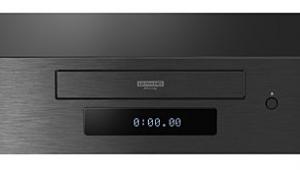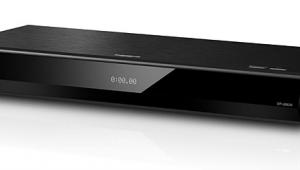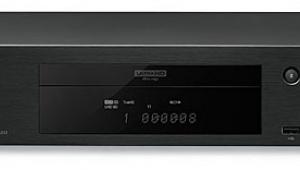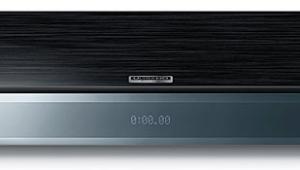Sony PlayStation 3 Game Console/ Blu-ray Disc Player
[Update: The best just keeps getting better. Sony has announced at long last that a firmware update available April 15th will allow the mighty PS3 to decode lossless DTS-HD Master Audio and DTS-HD High Resolution, a lossy, higher bitrate version of its codec. This was the last technological hurdle for Sony's mighty gaming console. For those with HDMI switching and an AVR or pre-pro that can process multichannel PCM the PS3 is unequivocally the Blu-ray player to beat. It's not only the fastest and most reliable BD player, it's the cheapest and most advanced. Look to this space for an update to this review once I've had a chance to experience DTS-HD MA and BD-Live. -SCB]
Manufacturers are burning through generations of Blu-ray Disc players faster than we can review them. Most are saddled with sluggish response times and varying degrees of obsolescence, with either interactivity or advanced audio—or both. It seems that every time a hot new title arrives that pushes the Blu-ray Disc Java (BD-J) interactivity envelope, it’s greeted with widespread reports of playback failures and new firmware downloads. This is par for the course—unless your Blu-ray Disc player happens to be a Sony PlayStation 3.

Sony’s PS3, the linchpin of Sony’s plans for Blu-ray’s world conquest, has not only withstood the tumult of this last year, but has gotten better and cheaper over time. Since we reviewed the PS3 in early 2007, Sony has upgraded it to support 1080p/24 output for Blu-ray Discs, upconversion of standard-def DVDs, and the most advanced BD-J interactivity.
Although it was released when first-generation Blu-ray players were on the market, the PS3 remains the fastest, slickest, and most reliable player out there. Oh, and it’s also among the cheapest.
Interactivity Monster
Since the PS3 received reviews back in March and April of 2007, I’m not going to revisit everything. Read those reviews to learn about the PS3’s unique XrossMediaBar interface and more. In addition, while the PS3 is a gaming console, a media hub, and so on, my focus here is on its Blu-ray performance, which is where we live and breathe here at Home Theater.
While the hardware platforms required to support Blu-ray’s BD-J interactivity are a moving target in the standalone players, the PlayStation 3 meets all of the foreseeable hardware requirements, up to BD-ROM Profile 2 and beyond. The PS3 can already play back streaming PiP “Bonus View” material. Web-enabled interactivity (dubbed BD-Live) has already started to appear on discs, and the PS3 was running these features flawlessly with beta-version firmware at the 2008 Consumer Electronics Show. (A production firmware update is imminent as I write this.) It’s hard to believe that there are second- and third-gen standalone BD players entering the market in the next few months that won’t be compatible with features that are already available on discs, but it’s true. Most current players won’t be upgradeable to support BD-Live, but by the time you read this, the PS3 will probably be there already.

The PS3 I’m using now is the first 60-gigabyte unit released in November of 2006. Most updates have added new features, as opposed to just fixing things that were broken. The original retail was $599. Currently, there is a 40-GB model on the market for $399 and an 80-GB model for $499. Both of the current models feature Wi-Fi, as my 60-GB model does, which is key for firmware updates (and now Web interactivity). Not being tethered to a hard-wired Ethernet line is a big plus for people who don’t have hard-wired Internet at their equipment rack. Love ’em or hate ’em, firmware updates are a way of life here in the next generation. Wi-Fi makes it super easy.
The $399 40-GB unit is every bit as advanced as any of the other PS3s for Blu-ray playback, and it’s still the least expensive Blu-ray player on the market. But gamers take note of the fact that, unlike other versions of the PS3, the 40-GB model isn’t backward-compatible with original PlayStation or PlayStation 2 games.
Taking Control
When HT first reviewed the PS3, the included SIXAXIS game controller had to be used as a remote. Sony now sells an aftermarket disc-player remote for $25. It’s not perfect, but it’s a big step up from the game controller. In addition, a company called Nyko has a USB plug-in adapter and remote combo that allows the PS3 to respond to IR commands. (PS3’s native tongue in remote control is Bluetooth.) Once the adapter is in, you can use the Nyko remote or program the PS3’s commands into a typical IR-based universal remote system.
Picture and Sound
The PS3 as a Blu-ray Disc player still makes the most sense for those with HDMI switching. Its component video outputs operate only to 1080i, and it doesn’t have multichannel analog audio outputs. It supports multichannel PCM, Dolby Digital Plus, and Dolby TrueHD only over HDMI. In spite of sporting an HDMI 1.3 output, the PS3 does not have the ability to output DD+ or TrueHD as native bitstreams; it converts both to multichannel PCM. My understanding is that lack of bitstream support is hardware level and will not be changed via firmware, ever.
The PS3 doesn’t support DTS-HD Master Audio as I write this, but it seemingly has the processing power to do so. Some have spoken of DTS-HD MA decoding as a question of when, not if, but so far it’s at least a “not yet.” Because the PS3 also lacks the ability to deliver DTS-HD MA as a native bitstream, this is the single area in which some newer standalone players can puff out their chests a little bit.
- Log in or register to post comments



























































